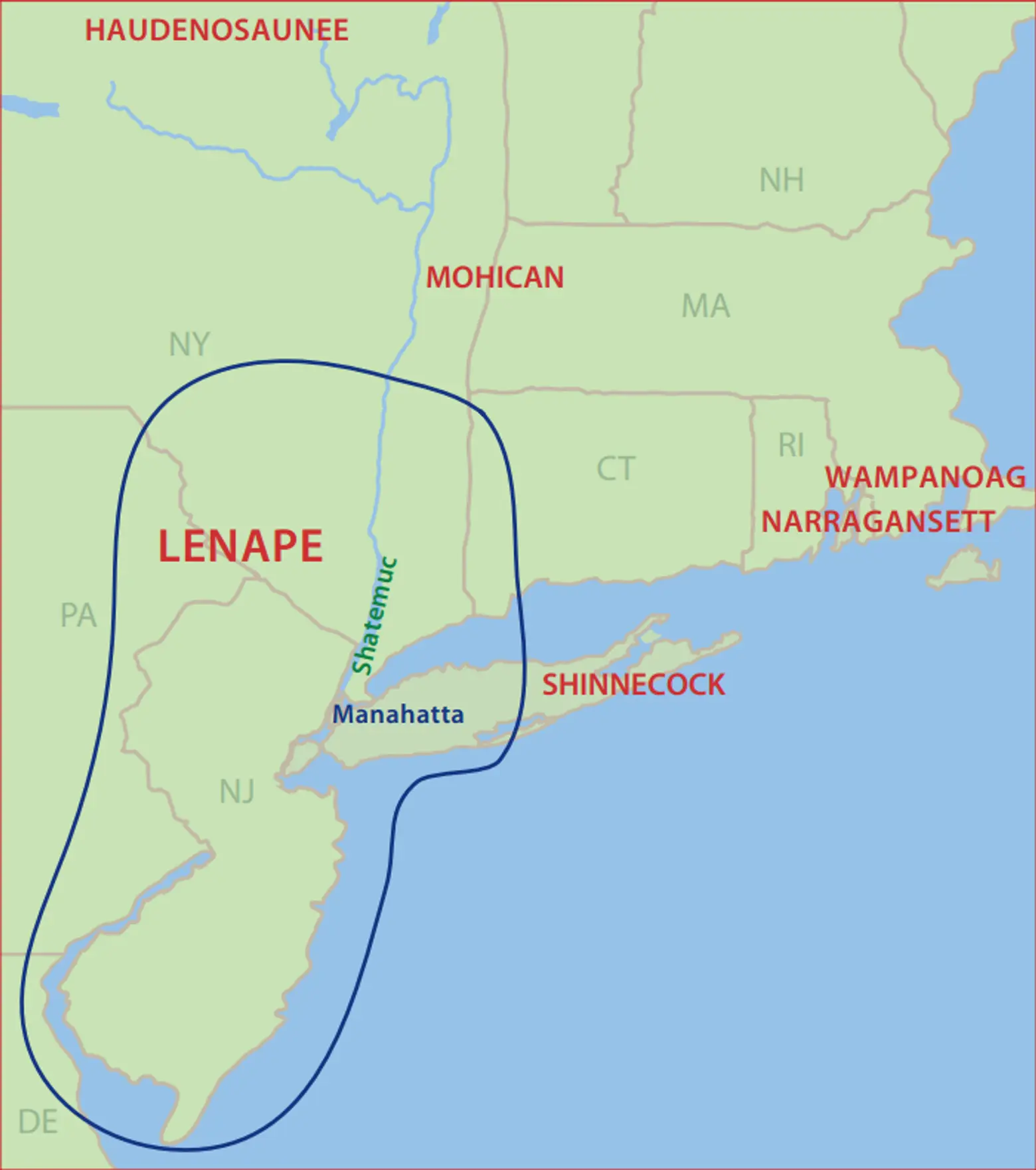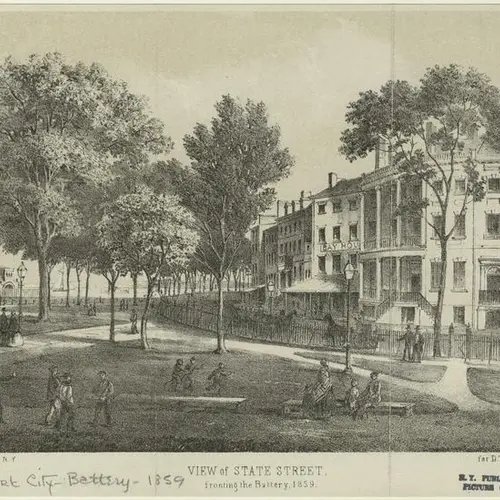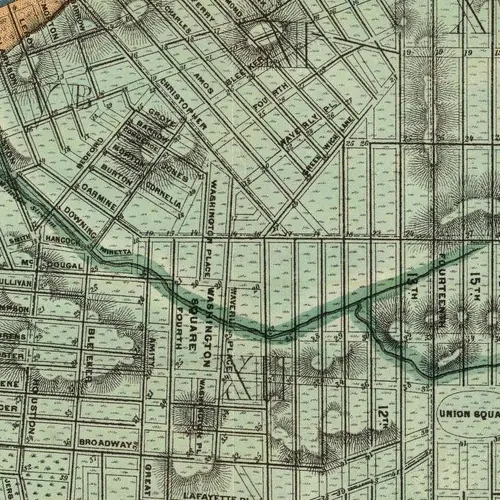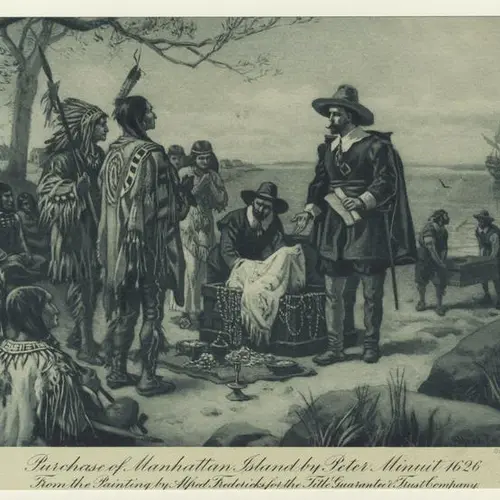Mapping Manahatta: 10 Lenape sites in New York City

“Manhattan Island in the Sixteenth Century,” from the Memorial History of New York, 1892, via NYPL
Currently, most Lenape belong to the Delaware Nation and live in New Jersey, Oklahoma, and Ontario, but the word Lenape means “Original People,” and the Lenape are the Original New Yorkers. In fact, the name Manhattan comes from the Lenape “Manahatta,” meaning “hilly island.” Although the Lenape stove to “walk so gently on the earth,” without leaving an impact on the land, they influenced the city’s physical geography in ways we can see and feel today. From Bowling Green to Broadway, Cherry Street to Minetta Lane, here are 10 sites in Manhattan that reflect the legacy of the Lenape.

The National Museum of American Indian at the foot of Broadway, via NMAI
1. Broadway
Today, the National Museum of the American Indian sits at the foot of Broadway in the Alexander Hamilton Customs house. It’s a fitting location for a museum devoted to the history and cultures of the native peoples of the Western Hemisphere because what is now called Broadway began as a Native American trade route that extended from New York Harbor all the way to present-day Boston, and was used by a host of indigenous tribes including the Lenape and the Mohicans.

State Street from the Battery, 1859, via NYPL
2. State Street
What’s now called State Street was once the southern tip of Manhattan Island. The Lenape called the point “Kapsee” meaning “sharp rock place,” and it was home to the Kapsee people who were leaders among the Canarsie group of the Lenape. When the Dutch arrived, they used the Lenape place-name, calling the site Copsey Street. It became known as State Street in 1793, when a statehouse was built in the area.

“Pearl Street in the Seventeenth Century,” from Annals of Old Manhattan, 1901, via NYPL
3. Pearl Street
Today’s Pearl Street began as a Lenape oyster midden along the east East River. Since New York Harbor was then home to half the world’s oysters, shells were piled several feet high along the riverbank. In fact, the shells were so abundant, Pearl Street was eventually paved with oyster shells. But, the Lenape discarded the oysters’ pearls along with their shells, and the Dutch dubbed the location Pearl Street because of the pearls that once adorned the riverbank.

George Washington’s House on Cherry Street, 1788 via NYPL
4. Cherry Street
What’s now the corner of Cherry Street and Franklin Square was once the edge of the Lenape’s vast cherry orchard. When the Dutch took control of the orchard, they created “Cherry Street” amidst the trees. George Washington himself later lived at 1 Cherry Street, and the home stood out as the nation’s first presidential residence. Traces of the orchard survived into the 1870s, when the last of the trees, and Washington’s home at 1 Cherry Street, were swept away to build the Brooklyn Bridge.

1902 depiction of the 1626 “sale” of Manhattan Island at Bowling Green, via NYPL
5. Bowling Green
While Cherry Street was the location of the first presidential mansion in the United States, the seat of power in Manahatta lay at Bowling Green. Now the city’s oldest park, Bowling Green was once home to the Kapsee chief, as well as to a sacred elm tree that marked one of the island’s most important meeting places. Under the tree, known as a Council Elm, the Lenape held Council Fires, crowds of people gathered to hear great orators, and residents arrived to trade or to socialize. Reportedly, the 1626 “trade” between the Lenape and the Dutch where Peter Minuit laid claim to Manhattan Island, took place under the Council Elm at Bowling Green.

New York Harbor and “Nutting Island,” 1768 via NYPL
6. Governor’s Island
Two years before that “trade,” a group of 30 Dutch families settled on an island the Lenape called “Pagganck,” which means “nut island,” so named for the area’s abundance of hickory nut trees. A village of Canarsie-speaking Lenape called the Island home.

Topographical map of NYC, 1865, showing Minetta Creek running under the street grid via Wikimedia Commons
7. Minetta Lane
A stream, known as Minetta Creek, runs beneath West 3rd Street, between McDougal Street and 6th Avenue. Today’s Minetta Lane and Minetta Street are named for the creek, which the Lenape called “Manetta,” which means “evil spirit,” or “snake water.” According to Evan T. Pritchard, director of the Center for Algonquin Culture, Manetta refers to the evil snake that had tormented the world from time immemorial until it was vanquished by the Lenape hero, Nanabush. Once the snake was conquered, all that remained was the snake-like creek, Manetta.

Washington Square Park still functions as a gathering space; via Wikimedia
8. Washington Square Park
Nearby, Washington Square serves roughly the same purpose today as the area did for the Lenape 500 years ago. Then as now, the location was a clearing that functioned as a gathering spot, marketplace and cultural hub where the Lenape played games or played music.
 Chief Red Cloud spoke at Cooper Union, overlooking Astor Place, a traditional spot location for Native American orators to speak, via NYPL
Chief Red Cloud spoke at Cooper Union, overlooking Astor Place, a traditional spot location for Native American orators to speak, via NYPL
9. Astor Place
Today’s Astor Place was an even larger Lenape gathering space. Known as “Kintecoying,” the area was a major inter-tribal crossroads where Manahatta’s three major Lenape groups came together. In 16th century Manahatta, the Canarsie, Sapohannikan and Manhattan people all converged for meetings, speeches councils, games, politics, trade and burials. Interestingly, in 1870, the influential Native American leader Red Cloud, chief of the largest tribe of the Teton Sioux Nation, appealed to the public at this very location, from the stage at Cooper Union, continuing a centuries-old tradition of Native American oratory at Astor Place.
 A map of “Lenapehoking” or The Dwelling Place of the Lenape, via The National Museum of the American Indian
A map of “Lenapehoking” or The Dwelling Place of the Lenape, via The National Museum of the American Indian
10. Park Avenue
When hundreds of Native Americans gathered at The Park Avenue Armory this weekend, they also continued a tradition of gathering on Park Avenue. Traditionally, several hundred Lenape people gathered in the vicinity of what is now Park Avenue and 98th street, at a seasonal basecamp for hunting and gathering known as Konaanderkongh.
RELATED:
- This 1946 map shows how Native American trails became the streets of Brooklyn
- Men of steel: How Brooklyn’s Native American ironworkers built New York
- Explore Manhattan When It Was Just Forests and Creeks With the 1609 Welikia Map
 Lucie Levine is the founder of Archive on Parade, a local tour and event company that aims to take New York’s fascinating history out of the archives and into the streets. She’s a Native New Yorker, and licensed New York City tour guide, with a passion for the city’s social, political and cultural history. She has collaborated with local partners including the New York Public Library, The 92nd Street Y, The Brooklyn Brainery, The Society for the Advancement of Social Studies and Nerd Nite to offer exciting tours, lectures and community events all over town. Follow her on Twitter and Instagram.
Lucie Levine is the founder of Archive on Parade, a local tour and event company that aims to take New York’s fascinating history out of the archives and into the streets. She’s a Native New Yorker, and licensed New York City tour guide, with a passion for the city’s social, political and cultural history. She has collaborated with local partners including the New York Public Library, The 92nd Street Y, The Brooklyn Brainery, The Society for the Advancement of Social Studies and Nerd Nite to offer exciting tours, lectures and community events all over town. Follow her on Twitter and Instagram.





































